Desa SCIVFC, SCIVFG, SCIVFB, SCIVFR User Manual
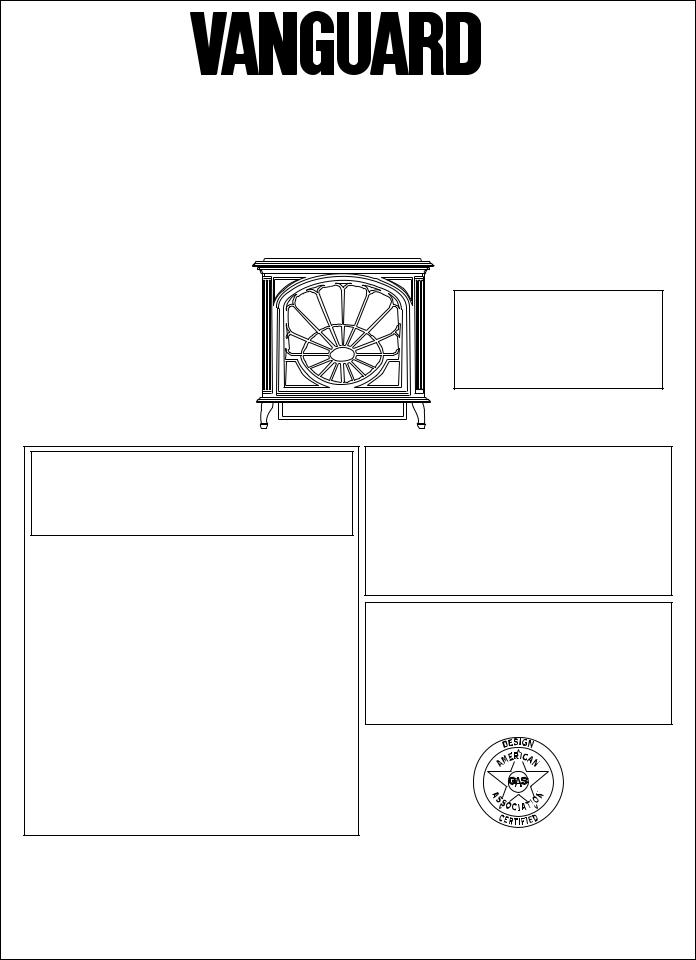
®
AMITYä (VENT-FREE)
PROPANE/LP GAS STOVE HEATER
OWNER’S OPERATION AND INSTALLATION MANUAL
AMITYä Stove Model Chassis With SVYD18P Variable Manually-Controlled Gas
Log Heater (Burner System For Amity Stove).
SCIVFC - Charcoal
SCIVFB - Azure Blue
SCIVFG - Hunter Green
SCIVFR - Burgundy Red
WARNING: If the information in this manual is not followed exactly, a fire or explosion may result causing property damage, personal injury, or loss of life.
—Do not store or use gasoline or other flammable vapors and liquids in the vicinity of this or any other appliance.
—WHAT TO DO IF YOU SMELL GAS
•Do not try to light any appliance.
•Do not touch any electrical switch; do not use any phone in your building.
•Immediately call your gas supplier from a neighbor’s phone. Follow the gas supplier’s instructions.
•If you cannot reach your gas supplier, call the fire department.
—Installation and service must be performed by a qualified installer, service agency, or the gas supplier.
WARNING: The SVYD18P vent-free gas log heater is only approved for use in the Amityä SCIVF(*) series stove models.
(* Indicates Color Suffix Designation)
WARNING: Improper installation, adjustment, alteration, service, or maintenance can cause injury or property damage. Refer to this manual for correct installation and operational procedures. For assistance or additional information consult a qualified installer, service agency, or the gas supplier.
WARNING: This is an unvented gasfired heater. It uses air (oxygen) from the room in which it is installed. Provisions for adequate combustion and ventilation air must be provided. Refer to
Air for Combustion and Ventilation section in this manual.
®
Patent Pending
Save this manual for future reference.
This appliance may be installed in an aftermarket* manufactured (mobile) home, where not prohibited by state or local codes. This appliance is only for use with the type of gas indicated on the rating plate. This appliance is not convertible for use with other gases.
* Aftermarket: Completion of sale, not for purpose of resale, from the manufacturer

CONTENTS
SAFETY INFORMATION
2
SECTION |
PAGE |
Safety Information ................................................................................... |
2 |
Product Identification .............................................................................. |
4 |
Local Codes ............................................................................................. |
4 |
Product Features ...................................................................................... |
4 |
Air for Combustion and Ventilation ........................................................ |
5 |
Installing .................................................................................................. |
8 |
Check Gas Type ............................................................................... |
8 |
Clearances to Combustibles (Vent-Free Operation Only) ............... |
8 |
Stove Cavity Assembly .................................................................... |
9 |
Installing Gas Log Heater Into Stove ............................................... |
13 |
Connecting to Gas Supply ................................................................ |
15 |
Checking Gas Connections .............................................................. |
17 |
Operating Heater ..................................................................................... |
19 |
Inspecting Burners ................................................................................... |
21 |
Cleaning and Maintenance ...................................................................... |
22 |
Troubleshooting ....................................................................................... |
22 |
Technical Service .................................................................................... |
26 |
Specifications .......................................................................................... |
26 |
Service Hints ........................................................................................... |
26 |
Replacement Parts ................................................................................... |
26 |
Accessory ................................................................................................ |
27 |
Illustrated Parts Lists ............................................................................... |
28-31 |
Warranty Information .............................................................................. |
Back Cover |
 WARNINGS
WARNINGS
IMPORTANT: Read this owner’s manual carefully and completely before trying to assemble, operate, or service this heater. Improper use of this heater can cause serious injury or death from burns, fire, explosion, electrical shock, and carbon monoxide poisoning.
 DANGER
DANGER
Carbon monoxide poisoning may lead to death!
Carbon Monoxide Poisoning: Early signs of carbon monoxide poisoning resemble the flu, with headaches, dizziness, or nausea. If you have these signs, the heater may not be working properly. Get fresh air at once! Have heater serviced. Some people are more affected by carbon monoxide than others. These include pregnant women, people with heart or lung disease or anemia, those under the influence of alcohol, and those at high altitudes.
Propane Gas: Propane gas is odorless. An odor-making agent is added to the gas. The odor helps you detect a gas leak. However, the odor added to the gas can fade. Gas may be present even though no odor exists.
Make certain you read and understand all Warnings. Keep this manual for reference. It is your guide to safe and proper operation of this heater.
Safety Information continues on next page
104025
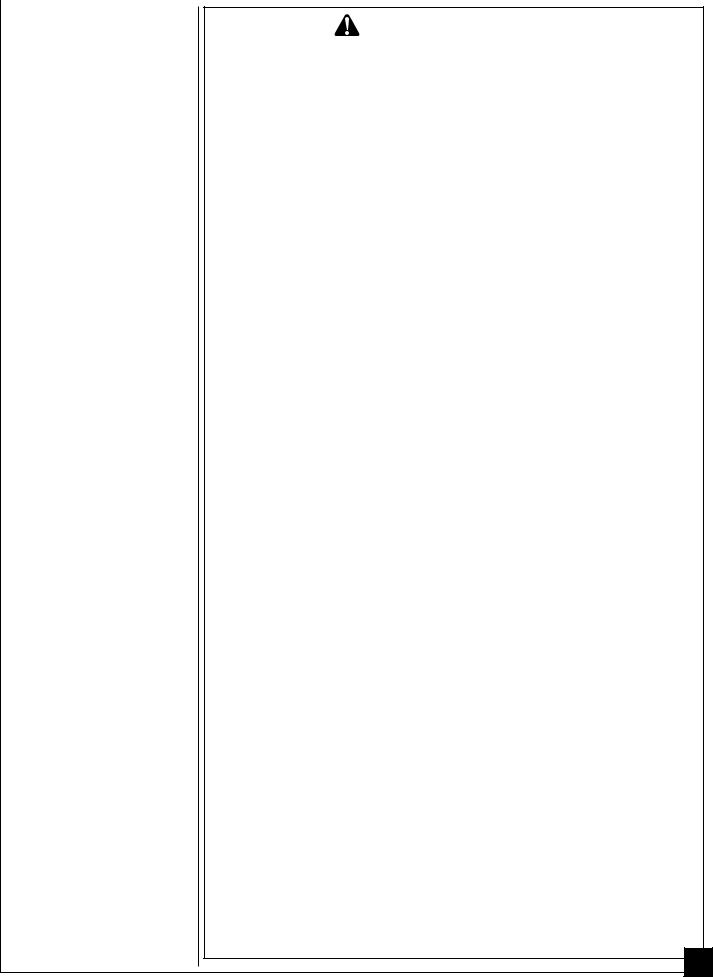
SAFETY |
|
WARNING ICON G 001 WARNINGS Continued |
|
|
WARNING: Any change to this heater or its controls can be dangerous. |
|
|||
INFORMATION |
1. |
This appliance is only for use with the type of gas indicated on the rating plate. This |
|
|
|
appliance is not convertible for use with other gases. |
|
||
Continued |
2. |
Do not place propane supply tank(s) inside any structure. Locate propane supply tank(s) |
|
|
|
|
outdoors. |
|
|
|
3. |
To prevent performance problems, the use of a propane tank of less than 100 lbs. |
|
|
|
|
capacity is not recommended. |
|
|
|
4. |
If you smell gas |
|
|
|
|
• shut off gas supply |
|
|
|
|
• do not try to light any appliance |
|
|
|
|
• do not touch any electrical switch; do not use any phone in your building |
|
|
|
|
• immediately call your gas supplier from a neighbor’s phone. Follow the gas |
|
|
|
|
supplier’s instructions |
|
|
|
|
• if you cannot reach your gas supplier, call the fire department |
|
|
|
5. |
This heater shall not be installed in a bedroom or bathroom. |
|
|
|
6. |
Never install the heater |
|
|
|
|
• in a recreational vehicle |
|
|
|
|
• where curtains, furniture, clothing, or other flammable objects are less than the |
|
|
|
|
minimum clearances to combustibles (see page 8) from the front, top, or sides of |
|
|
|
|
the heater |
|
|
|
|
• in high traffic areas |
|
|
|
|
• in windy or drafty areas |
|
|
|
7. |
Do not use this stove as a wood burning fireplace. Use only model SVYD18P vent- |
|
|
|
|
free gas log heater. |
|
|
|
8. |
Do not add extra logs or ornaments such as pine cones, vermiculite, or rock wool. |
|
|
|
|
Using these added items can cause sooting. |
|
|
|
9. |
This log heater is designed to be smokeless. If logs ever appear to smoke, turn off |
|
|
|
|
heater and call a qualified service person. Note: During initial operation, slight |
|
|
|
|
smoking could occur due to log curing and heater burning manufacturing residues. |
|
|
|
10. |
Do not allow fans to blow directly into the stove. Avoid any drafts that alter burner |
|
|
|
|
flame patterns. Ceiling fans can create drafts that alter burner flame patterns. Altered |
|
|
|
|
burner patterns can cause sooting. |
|
|
|
11. |
Do not use a blower insert, heat exchanger insert or other accessory not approved for |
|
|
|
|
use with this heater. |
|
|
|
12. |
This heater needs fresh, outside air ventilation to run properly. This heater has an oxygen |
|
|
|
|
depletion sensor (ODS) pilot light safety system. The ODS shuts down the heater if not |
|
|
|
|
enough fresh air is available. See Air for Combustion and Ventilation, pages 5 through |
|
|
|
|
8. If heater keeps shutting off, see Troubleshooting, pages 22 through 25. |
|
|
|
13. |
Do not run heater |
|
|
|
|
• where flammable liquids or vapors are used or stored |
|
|
|
|
• under dusty conditions |
|
|
|
14. |
Do not use this stove to cook food or burn paper or other objects. |
|
|
|
15. |
Never place any objects on the stove. |
|
|
|
16. |
Stove becomes very hot when running heater. Keep children and adults away from |
|
|
|
|
hot surface to avoid burns or clothing ignition. Heater will remain hot for a time after |
|
|
|
|
shut-down. Allow surface to cool before touching. |
|
|
|
17. |
Carefully supervise young children when they are in the room with heater. |
|
|
|
18. |
Do not use heater if any part has been exposed to or under water. Immediately call a |
|
|
|
|
qualified service technician to inspect the room heater and to replace any part of the |
|
|
|
|
control system and any gas control which has been under water. |
|
|
|
19. |
Do not operate heater if any log is broken. Do not operate heater if a log is chipped |
|
|
|
|
(dime-sized or larger). |
|
|
|
20. |
Turn heater off and let cool before servicing. Only a qualified service person should |
|
|
|
|
service and repair heater. |
|
|
|
21. |
Operating heater above elevations of 4,500 feet could cause pilot outage. |
|
|
|
|
|
||
3
104025

PRODUCT IDENTIFICATION
LOCAL CODES
PRODUCT
FEATURES
4
Stove Body
One Piece
Log Set
Inside Stove
Cavity
|
|
|
|
|
|
|
|
|
|
|
|
|
|
|
|
|
|
Piezo Ignitor |
|
Control Knob |
|||
|
|
|
|||||
|
|
|
|||||
Stove Door |
|
|
|
||||
Gas Log Heater |
|||||||
(Shown in the |
|||||||
Base Assembly |
|||||||
open position) |
|||||||
|
|
|
|||||
Figure 1 - Amityä Stove Cabinet Model SCIVF(*) with Amityä Gas Log Heater Model SVYD18P
(* Indicates Color Suffix Designation)
Install and use heater with care. Follow all local codes. In the absence of local codes, use the latest edition of The National Fuel Gas Code ANSI Z223, also known as NFPA 54*.
*Available from: American National Standards Institute, Inc. 1430 Broadway
New York, NY 10018
National Fire Protection Association, Inc.
Batterymarch Park
Quincy, MA 02269
Operation
This heater is clean burning. It requires no outside venting. There is no heat loss out a vent or up a chimney. Heat is generated by realistic, dancing yellow flames. This heater is designed for vent-free operation. State and local codes in some areas prohibit the use of vent-free heaters.
Safety Pilot
This heater has a pilot with an Oxygen Depletion Sensor Shutoff System (ODS). The ODS/pilot is a required feature for vent-free room heaters. The ODS/pilot shuts off the heater if there is not enough fresh air.
Piezo Ignition System
This heater has a piezo ignitor. This system requires no matches, batteries, or other sources to light heater.
104025

AIR FOR |
|
WARNING ICON G 001 WARNING |
COMBUSTION |
|
This heater shall not be installed in a confined space unless |
AND |
|
provisions are provided for adequate combustion and ventila- |
|
tion air. Read the following instructions to insure proper fresh |
|
VENTILATION |
|
air for this and other fuel-burning appliances in your home. |
|
|
Today’s homes are built more energy efficient than ever. New materials, in- |
|
|
creased insulation, and new construction methods help reduce heat loss in homes. |
|
|
Home owners weather strip and caulk around windows and doors to keep the cold |
|
|
air out and the warm air in. During heating months, home owners want their |
|
|
homes as airtight as possible. |
|
|
While it is good to make your home energy efficient, your home needs to breathe. |
|
|
Fresh air must enter your home. All fuel-burning appliances need fresh air for |
|
|
proper combustion and ventilation. |
|
|
Exhaust fans, fireplaces, clothes dryers, and fuel burning appliances draw air |
|
|
from the house to operate. You must provide adequate fresh air for these appli- |
|
|
ances. This will insure proper venting of vented fuel-burning appliances. |
|
PROVIDING ADEQUATE VENTILATION |
|
|
The following is excerpts from National Fuel Gas Code. NFPA 54/ANSI Z223.1, |
|
|
Section 5.3, Air for Combustion and Ventilation. |
|
|
All spaces in homes fall into one of the three following ventilation classifications: |
|
|
1. Unusually Tight Construction; 2. Unconfined Space; 3. Confined Space. |
|
|
The information on pages 5 through 7 will help you classify your space and provide |
|
|
adequate ventilation. |
|
|
Unusually Tight Construction |
|
|
The air that leaks around doors and windows may provide enough fresh air for |
|
|
combustion and ventilation. However, in buildings of unusually tight construc- |
|
|
tion, you must provide additional fresh air. |
|
|
|
Unusually tight construction is defined as construction where: |
|
|
a. walls and ceilings exposed to the outside atmosphere have a con- |
|
|
tinuous water vapor retarder with a rating of one perm (6x10-11 per |
|
2 |
|
|
|
pa•sec•m) or less with openings gasketed or sealed and |
|
|
b. weather stripping has been added on openable windows and doors |
|
|
and |
|
|
c. caulking or sealants are applied to areas such as joints around window |
|
|
and door frames, between sole plates and floors, between wall-ceiling |
|
|
joints, between wall panels, at penetrations for plumbing, electrical, and |
|
|
gas lines, and at other openings. |
|
If your home meets all of the three criteria above, you must provide addi- |
|
|
tional fresh air. See Ventilation Air From Outdoors, page 7. |
|
|
If your home does not meet all of the three criteria above, proceed to page 6. |
|
|
Confined and Unconfined Space |
|
|
The National Fuel Gas Code (ANSIZ223.1, 1992 Section 5.3) defines a confined space |
|
|
as a space whose volume is less than 50 cubic feet per 1,000 Btu per hour (4.8 m3 per |
|
|
kw) of the aggregate input rating of all appliances installed in that space and an |
|
|
unconfined space as a space whose volume is not less than 50 cubic feet per 1,000 Btu |
|
|
per hour (4.8 m3 per kw) of the aggregate input rating of all appliances installed in that |
|
|
space. Rooms communicating directly with the space in which the appliances are |
|
|
installed*, through openings not furnished with doors, are considered a part of the |
|
|
unconfined space. |
|
* Adjoining rooms are communicating only if there are doorless passageways or
ventilation grills between them. |
Continued |
5 |
|
|
104025

AIR FOR COMBUSTION AND VENTILATION
Continued
6
DETERMINING AIR FLOW FOR HEATER LOCATION
Determining if You Have a Confined or Unconfined Space
Use this work sheet to determine if you have a confined or unconfined space.
Space: Includes the room in which you will install heater plus any adjoining rooms with doorless passageways or ventilation grills between the rooms.
1. Determine the volume of the space (length x width x height).
Length x Width x Height = ___________________ cu. ft. (volume of space) Example: Space size 20 ft. (length) x 16 ft. (width) x 8 ft. (ceiling height) =
2560 cu. ft. (volume of space)
If additional ventilation to adjoining room is supplied with grills or openings, add the volume of these rooms to the total volume of the space.
2.Divide the space volume by 50 cubic feet to determine the maximum Btu/Hr the space can support.
____________ (volume of space) ÷ 50 cu. ft. = (maximum Btu/Hr the space can support)
Example: 2560 cu. ft. (volume of space) ÷ 50 cu. ft. = 51.2 or 51,200 (maximum Btu/Hr the space can support)
3. Add the Btu/Hr of all fuel burning appliances in the space.
Vent-free heater |
|
___________________ Btu/Hr |
|
Gas water heater* |
|
___________________ Btu/Hr |
|
Gas furnace |
|
___________________ Btu/Hr |
|
Vented gas heater |
|
___________________ Btu/Hr |
|
Gas fireplace logs |
|
___________________ Btu/Hr |
|
Other gas appliances* |
+ ___________________ Btu/Hr |
||
Total |
= ___________________ Btu/Hr |
||
Example: Gas water heater |
|
40,000 |
Btu/Hr |
Vent-free heater |
+ |
30,000 |
Btu/Hr |
Total |
= |
70,000 |
Btu/Hr |
* Do not include direct-vent gas appliances. Direct-vent draws combustion air from the outdoors and vents to the outdoors.
4. Compare the maximum Btu/Hr the space can support with the actual amount of Btu/Hr used.
_________________ |
Btu/Hr (maximum the space can support) |
_________________ |
Btu/Hr (actual amount of Btu/Hr used) |
Example: 51,200 |
Btu/Hr (maximum the space can support) |
70,000 |
Btu/Hr (actual amount of Btu/Hr used) |
The space in the above example is a confined space because the actual Btu/Hr used is more than the maximum Btu/Hr the space can support. You must provide additional fresh air. Your options are as follows:
A.Rework worksheet, adding the space of an adjoining room. If the extra space provides an unconfined space, remove door to adjoining room or add ventilation grills between rooms. See Ventilation Air From Inside Building, page 7.
B.Vent room directly to the outdoors. See Ventilation Air From Outdoors, page 7.
C.Install a lower Btu/Hr heater, if lower Btu/Hr size makes room unconfined.
If the actual Btu/Hr used is less than the maximum Btu/Hr the space can support, the space is an unconfined space. You will need no additional fresh air ventilation.
104025
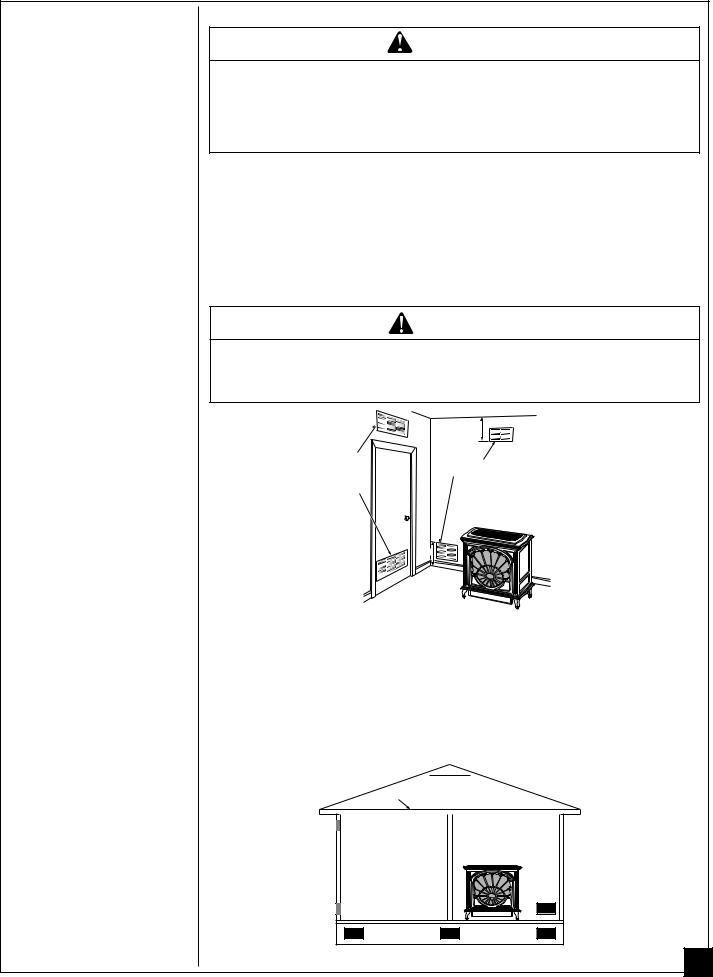
AIR FOR |
|
|
WARNING |
|
COMBUSTION |
|
|
||
If the area in which the heater may be operated is smaller than |
||||
AND |
that defined as an unconfined space, provide adequate combus- |
|||
tion and ventilation air by one of the methods described in the |
||||
VENTILATION |
||||
National Fuel Gas Code, ANSI Z223.1, 1992, Section 5.3 or appli- |
||||
Continued |
cable local codes. |
|
|
|
|
|
|
||
|
VENTILATION AIR |
|
|
|
|
Ventilation Air From Inside Building |
|||
|
This fresh air would come from an adjoining unconfined space. When ventilating to an |
|||
|
adjoining unconfined space, you must provide two permanent openings: one within 12" of the |
|||
|
ceiling and one within 12" of the floor on the wall connecting the two spaces (see options 1 |
|||
|
and 2, Figure 2). You can also remove door into adjoining room (see option 3, Figure 2). |
|||
|
Follow the National Fuel Gas Code NFPA 54/ANSI Z223.1, Section 5.3, Air for Combustion |
|||
|
and Ventilation for required size of ventilation grills or ducts. |
|||
|
|
WARNING ICON G 001 WARNING |
||
|
Rework worksheet, adding the space of the adjoining unconfined |
|||
|
space. The combined spaces must have enough fresh air to supply all |
|||
|
appliances in both spaces. |
|
||
|
|
|
12" |
|
|
Ventilation |
|
Ventilation Grills |
|
|
Grills |
|
||
|
Into Adjoining |
Or |
Into Adjoining Room, |
|
|
Room, |
Option 2 |
||
|
Remove |
|||
|
Option 1 |
|
||
|
Door into |
|
||
|
|
|
||
|
|
Adjoining |
|
|
|
|
Room, |
|
|
|
|
Option |
|
|
|
|
3 |
|
|
|
|
|
12" |
|
Figure 2 - Ventilation Air from Inside Building
Ventilation Air From Outdoors
Provide extra fresh air by using ventilation grills or ducts. You must provide two permanent openings: one within 12" of the ceiling and one within 12" of the floor. Connect these items directly to the outdoors or spaces open to the outdoors. These spaces include attics and crawl spaces.
IMPORTANT: Do not provide openings for inlet or outlet air into attic if attic has a thermostat-controlled power vent. Heated air entering the attic will activate the power vent. 
|
|
Outlet |
|
|
|
Ventilated |
||
|
|
|
|
|
Attic |
|||
|
|
Air |
|
|
|
|||
|
|
|
|
|
|
|
|
|
Outlet |
|
|
|
|
|
|
|
|
|
|
|
|
|
|
|
|
|
|
|
|
|
|
|
|
|
|
Air |
|
|
|
|
|
|
|
|
|
|
|
|
|
|
To Attic |
||
|
To |
|
|
Crawl |
|
Inlet |
Space |
|
|
|
|
Air |
|
|
Inlet Air |
Ventilated |
|
Crawl Space |
|
|
|
|
|
Figure 3 - Ventilation Air from Outdoors |
7 |
|
104025
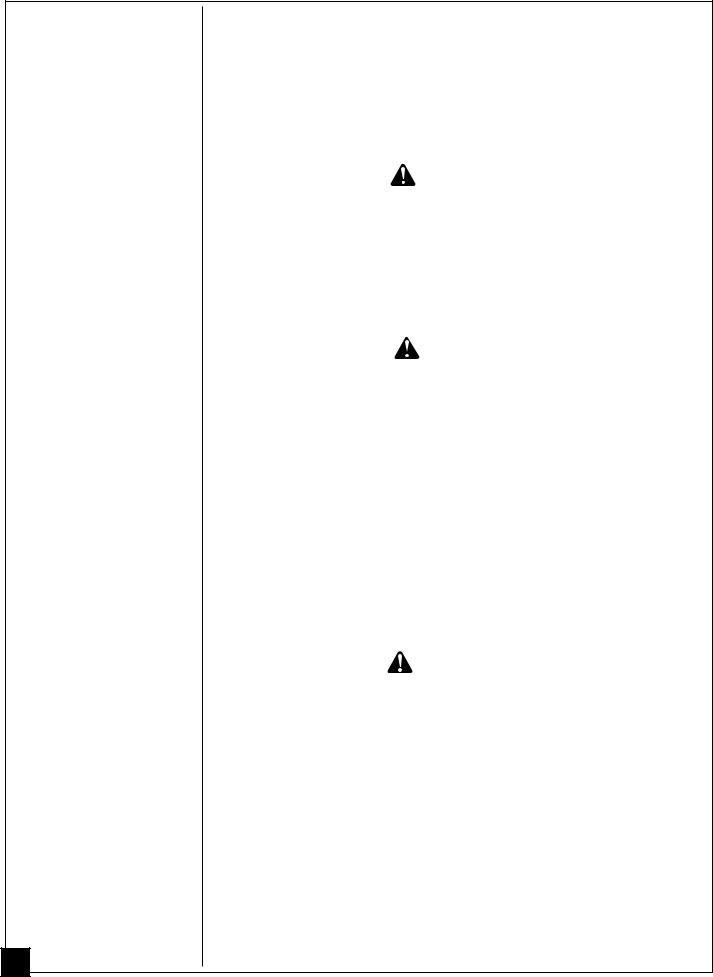
INSTALLING |
NOTICE |
|
A qualified service person must install heater. Follow all local codes. |
|
|
|
|
|
NOTICE |
|
State or local codes may only allow operation of this appliance in a |
|
vented configuration. Check your state or local codes. |
|
|
|
|
|
WARNING |
|
Never install the heater |
|
• in a bedroom or bathroom |
|
• in a recreational vehicle |
|
• where curtains, furniture, clothing, or other flammable objects are |
|
less than 36 inches from the front, top, or sides of the heater |
|
• in high traffic areas |
|
• in windy or drafty areas |
|
|
|
|
|
WARNING ICON G 001 CAUTION |
|
This heater creates warm air currents. These currents move heat |
|
to wall surfaces next to heater. Installing heater next to vinyl or |
|
cloth wall coverings or operating heater where impurities in the air |
|
(such as tobacco smoke) exist, may discolor walls. |
|
|
|
IMPORTANT: Vent-free heaters add moisture to the air. Although this is benefi- |
|
cial, installing heater in rooms without enough ventilation air may cause mildew |
|
to form from too much moisture. See Air for Combustion and Ventilation, pages 5 |
|
through 7. |
|
CHECK GAS TYPE |
|
Use only propane gas. If your gas supply is not propane, do not install heater. Call |
|
dealer where you bought heater for proper type heater. |
|
CLEARANCES TO COMBUSTIBLES (Vent-Free Operation Only) |
|
|
|
WARNING |
|
Maintain the minimum clearances. If you can, provide greater clear- |
|
ances from floor, ceiling, and adjoining side and back walls. |
|
|
|
Carefully follow the instructions below. This stove is a freestanding unit designed |
|
to set directly on the floor. IMPORTANT: You must maintain minimum wall and |
|
ceiling clearances during installation. The minimum clearances are shown in |
|
Figure 4, page 9. Measure from outermost point of stove top. |
|
Minimum Wall and Ceiling Clearances (see Figure 4) |
|
A. Clearances from outermost point of stove top to any combustible side wall |
|
should not be less than 12 inches. |
|
B. Clearances from outermost point of stove top to any combustible back wall |
|
should not be less than 6 inches (Includes Corner Installations). |
|
C. Clearances from the stove top to the ceiling should not be less than 48 inches. |
8
104025

INSTALLING |
|
Front View |
|
|
|
Ceiling |
|
||
|
|
|
||
Continued |
|
|
|
|
|
|
48" |
|
|
|
|
Minimum |
|
|
Side Wall |
12" |
12" |
Side Wall |
|
Minimum |
Minimum |
|||
|
|
|
Top View |
|
|
|
Back Wall |
|
|
|
6 |
" |
Side View |
|
Minimum |
||
|
|
||
|
12 " |
12 " |
Ceiling |
|
Minimum |
Minimum |
|
Side Wall |
|
|
Side Wall |
|
|
|
48" |
|
|
|
Minimum |
Corner |
Wall |
|
Back Wall |
|
|
|
6" |
|
|
|
Minimum |
|
6 " |
|
|
|
Minimum |
|
|
Front of
Stove Unit
Wall |
6 " |
|
Minimum |
|
|
Floor
Figure 4 - Minimum Clearance to Walls and Ceiling
STOVE CAVITY ASSEMBLY
1.Lift off corrugated box enclosing stove body crating.
2.Remove all screws fastening the wood frame enclosure. Spread wood frame open and lift away from plastic-bagged stove body. The bottom pieces of pallet wood will remain bolted to the stove body.
3.Remove plastic bag from stove body.
4.Remove back panel from stove (see Figure 5). Use an adjustable wrench or a 10 mm socket. Remove six (6) bolts and washers. Keep bolts and washers to reattach back panel later.
Bolt |
|
|
Product |
Back Stove Panel |
|
|
|
|
Identification |
|
|
Label |
|
|
Figure 5 - Removing Back Panel |
Continued |
9 |
|
|
104025
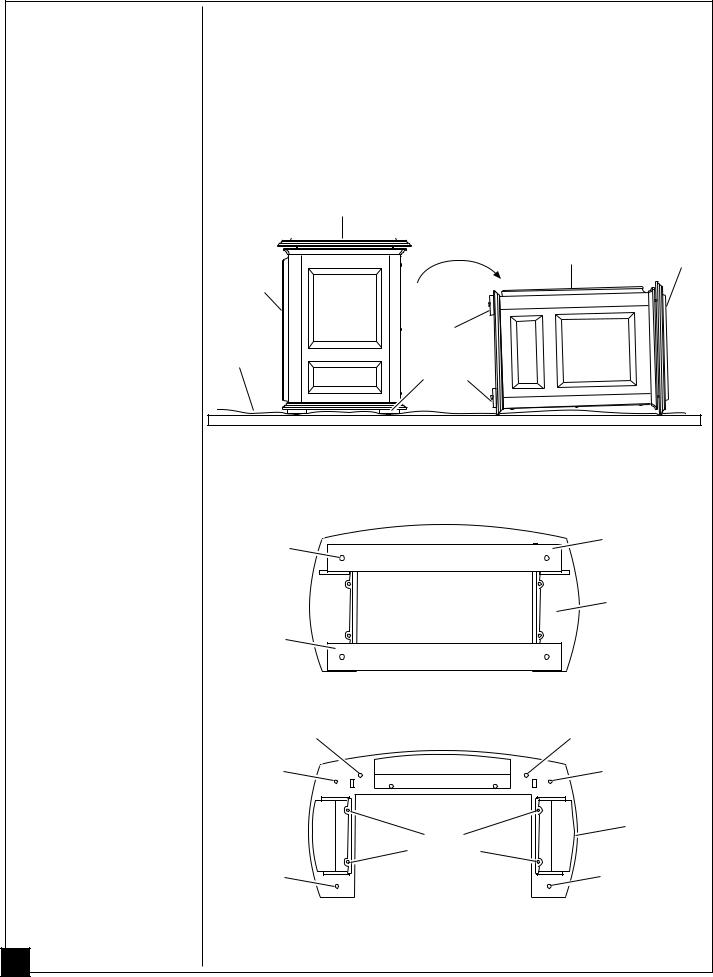
INSTALLING |
5. Remove all contents from inside stove cavity. Contents include: |
||
(1) |
- Stove bottom |
||
|
|||
Continued |
(4) - Legs with leg leveler bolts |
||
|
(1) |
- Bottom door |
|
|
(1) |
- Top grate |
|
(1)- Hardware kit bag with fasteners
6.Carefully lay stove body on back to attach bottom components to stove body (see Figure 6). Rest stove on drop cloth or blanket to avoid scratching stove edges.
Top of
Stove Unit
Front of |
Top of |
|
Stove Unit |
||
Stove Unit |
||
|
Front of
Stove Unit
Pallet Wood
Drop Cloth/ |
Bolted to |
|
Blanket |
||
Stove Body |
||
|
||
|
Bottom |
Figure 6 - Laying Down Stove On Side
7.Remove remaining pallet wood attached to bottom of stove body (see Figure 7). Use an adjustable wrench to remove bolts.
Front
Bolt |
Pallet |
|
Wood |
||
|
Bottom Of
Stove Unit
Pallet
Wood
Figure 7 - Removing Pallet Wood From The Bottom of The Stove
Door Hinge Step |
|
Door Catch Bolt |
Bolt Hole |
Front |
With Adjustable |
|
Hex Nuts Hole |
|
|
|
|
Leg |
|
Leg |
Hole |
|
Hole |
Bottom Of
Stove Stove Unit
Bottom Hole
Leg |
Leg |
Hole |
Hole |
Figure 8 - Locating of Threaded Holes for Stove
Bottom, Legs, and Door Attachment
10
104025
